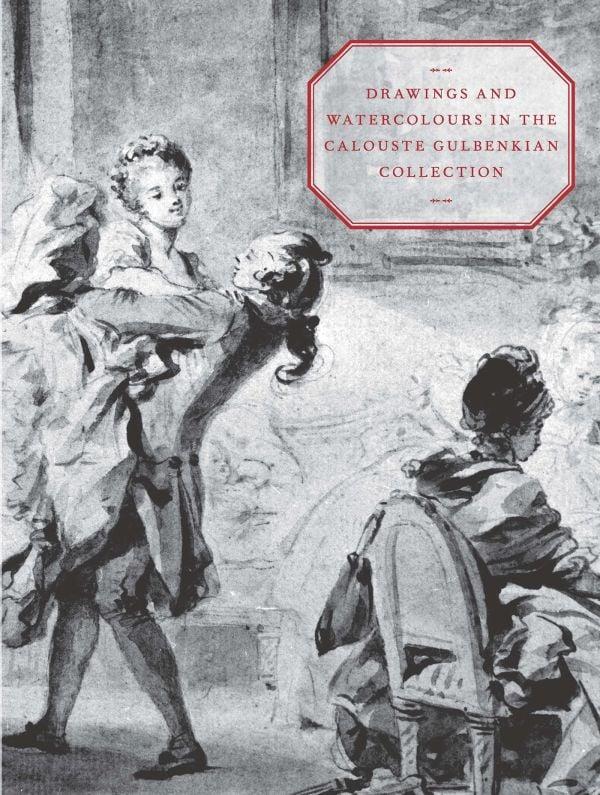
1. His artistic roots in the Gothic tradition and his interest in exquisitely detailed decorative elements came from his training as a goldsmith in his father’s workshop between 1485 and 1486 and from his apprenticeship in the studio of the painter/printmaker Michael Wolgemut (1433/1434–1519) until 1489. In the former he discovered the world of drawing and metal engraving, and in the latter he entered the world of painting and printmaking for book illustration.
2. Even before these trips, Dürer had already been won over by the humanist culture that had come to his attention through his compatriot and long-standing friend, Willibald Pirckheimer (1470–1530), and through his contact with the intellectual circles that surrounded him.
ALBRECHT DÜRER
Nuremberg, 1471–1528
Dead Duck
Germany, ca. 1502 (?) or ca. 1512 (?)
Pen and brush, watercolour, gouache, black ink, graphite tracing with gilded heightening on parchment.
22.6(4) × 12.4 cm
Date and monogram near the bird’s head: “1515 AD” (false). Inv. 1 40
Dürer’s vast body of work is located on the turning point between two eras in the transition between the Middle Ages and the Renaissance. Born in Nuremberg at a time of intense social, religious, cultural, and political change, Dürer’s art melded the legacy of the German late-Gothic1 with the humanist ideals that were flourishing in Italy at the time, and which he assimilated especially over the course of his two stays there in 1494–95 and 1505–7 2 . ¶ He was a precociously talented artist, and in his quest to go beyond the limitations of his formative years Dürer was naturally drawn to Renaissance ideas. This was conveyed in his work through a rationalist world view and through his search for classical references, some of which he was already familiar with through Italian art and aesthetics 3 . ¶ Talented in all forms of artistic expression, particularly printmaking, Dürer was unsurpassed in his drawing, which was the key to his entire body of work and his preferred medium for all his artistic reflections. This can be seen in the vast array of preparatory studies for his engraved and painted subjects and in his autonomous studies of landscapes, plants or animals that were then frequently expressed in watercolours. ¶ In his search for universal values, Dürer, like Leonardo da Vinci, took nature as his continual source of inspiration. He was a patient and objective observer and he successfully communicated the individual characteristics of every element through drawings that were so full of life and technical virtuosity that they seemed almost real, as exemplified in the studies Young Hare and The Great Piece of Turf 4 . ¶ The drawing Dead Duck, which belongs to the Gulbenkian Collection, is one of Dürer’s finest nature studies. In this composition the German master shows a diving duck (Athya ferina), a common breed in Northern and Central Europe that is easy to identify by its hazel coloured neck and blue-grey plumage. The bird is depicted as a hunting trophy, hung from a nail in the wall on a string strung through its nostrils. It is shown in sharp profile from its beak down to the start of its body, with its lower half turned only slightly to the left. The way that the heavy body is hung has distended the neck muscles,
3. The concept of perspective and the canons of proportions for the human body that had always interested him encouraged him to continue his studies and to research the writings of Vitruvius on the subject. In the final years of his life he published several treatises on these theories: Unterweisung der Messung [Teaching of Measurement] (1525); Treatise on Fortification (1527); and Vier Bücher von menschlicher Proportion [Four Books on Human Proportion] (1528, the last two of which were published posthumously).
4. Vienna, Graphische Sammlung Albertina, inv. 3 073 and 3075.
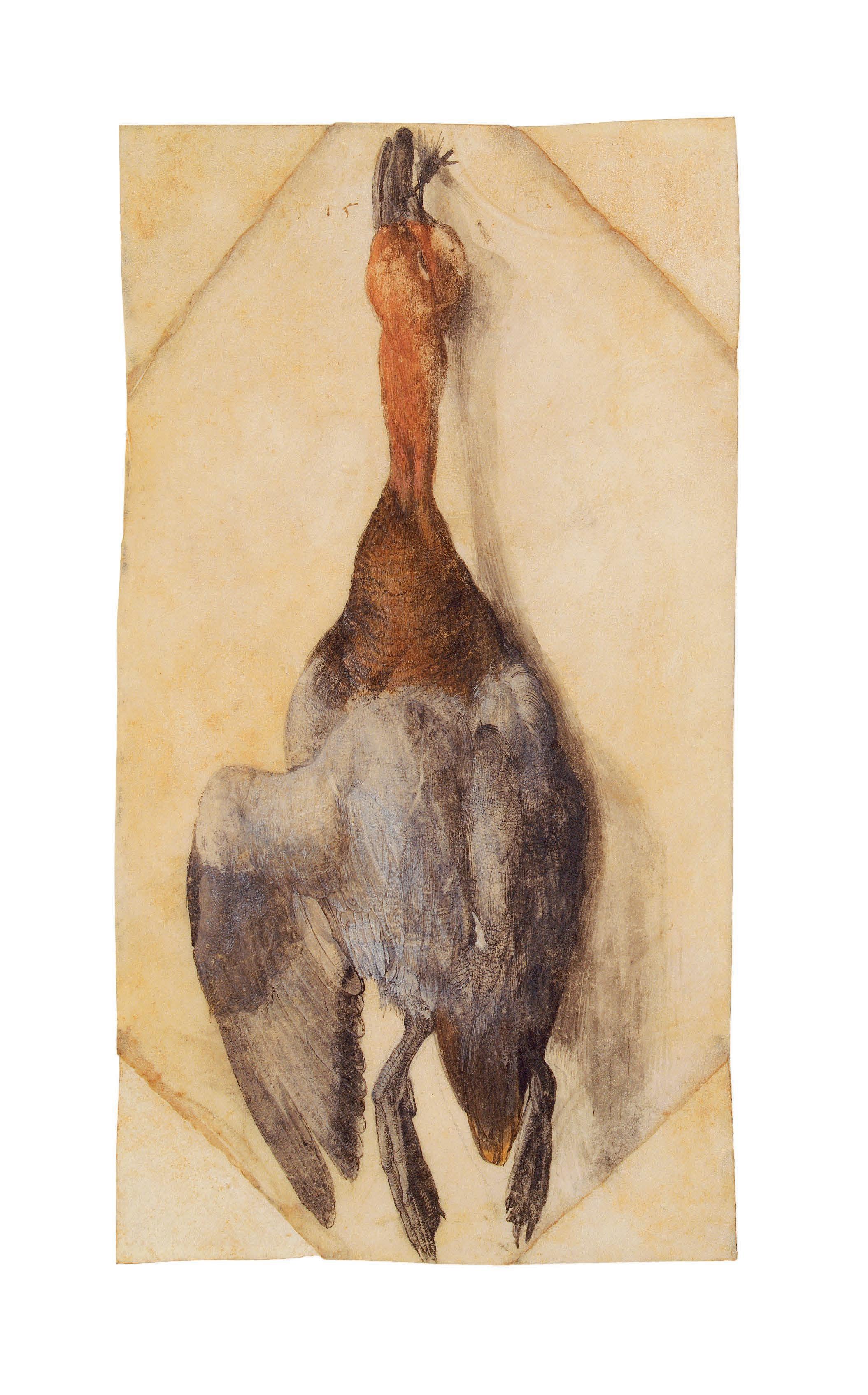
and the head of Sextus (which is set more artificially on the character’s shoulders) (fig. 6.2). Interestingly, there is another Mieris drawing in Amsterdam’s Rijksmuseum collections which, despite having a very similar composition to that of the Gulbenkian piece and the painting, was made before either work. In the Rijksmuseum drawing, however, it is not possible to identify the subject of the sketched bas-relief in the background (fig. 6.3) 10 . ¶ According to previous studies, this painting was sold at successive public sales and was presented by the London art dealers Verner Amell Ltd in Maastricht at the European Art Fair in 199111 Curiously, at an auction held at Christie’s of London on 7 July 2010, a painting by Willem van Mieris on this same subject was listed under lot no. 121. This piece
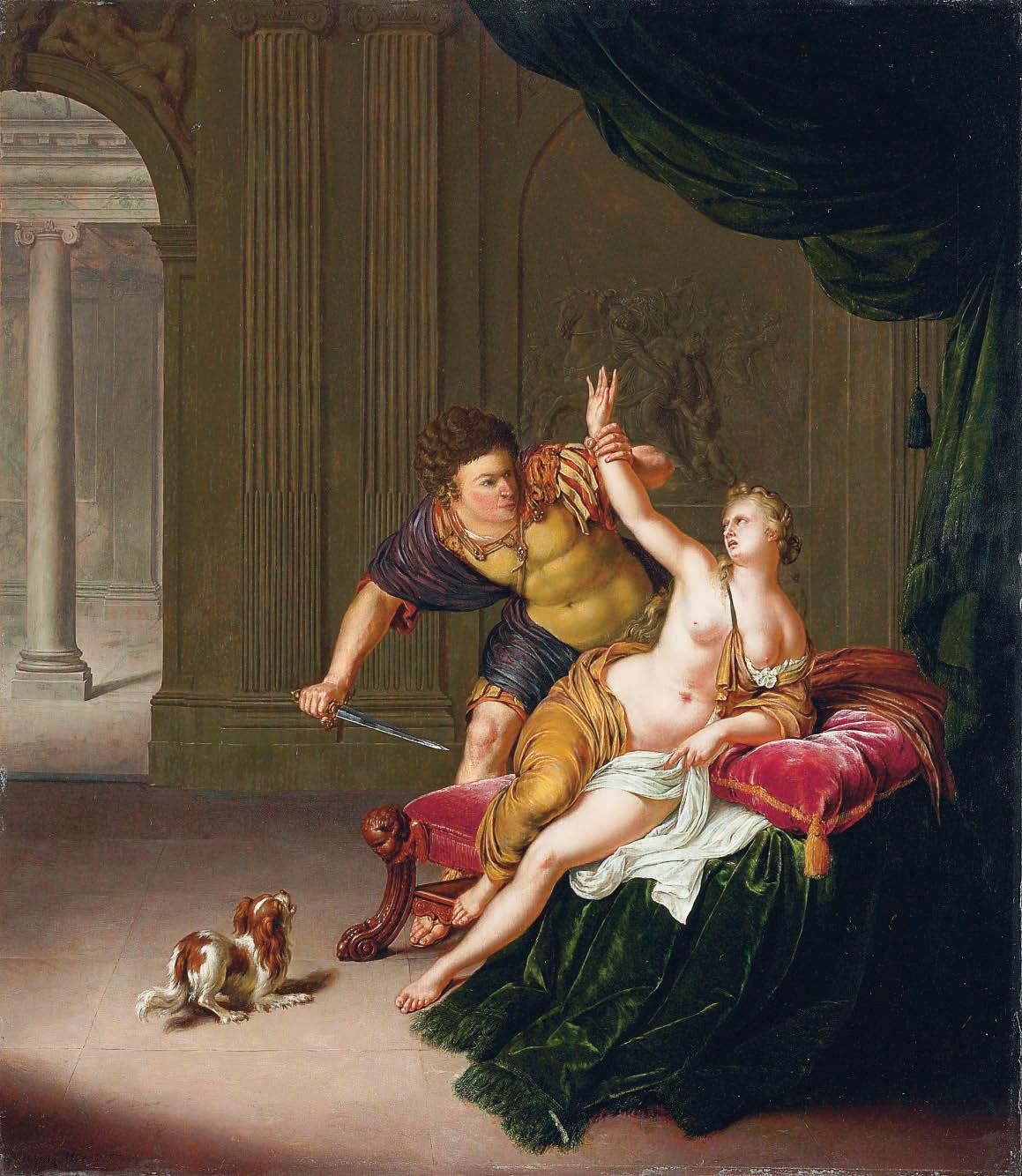
10.
11.
– fig. 6.2 –Willem van Mieris (1662–1747), The Rape of Lucretia. Oil on panel. © Christie’s Images Limited (2013)
12. Benjamin Peronnet of Christie’s, to whom I am grateful for all of the information that he provided on the subject (2012), told me that the painting was not actually sold at this auction.
13. THE HAGUE , WASHINGTON , 2005–2006 , pp. 207–9 , ill.
was identical to the drawing 12 and may therefore have been the work displayed in 1991. ¶ Painters and writers find in the story of Lucretia an inexhaustible source of inspiration for their works. Titian, Tintoretto, Rubens, Cranach, Veronese and Rembrandt, among others, depicted it in their paintings, and Shakespeare himself tackled it in his narrative poem The Rape of Lucrece, which was published in 1594 and dedicated to one of his patrons, Henry Wriothesley, the Earl of Southampton. There are therefore numerous sources that may have inspired Van Mieris. We may recall that his father, although not habitually a painter of historical subjects, had in 1679 made a painting entitled The Death of Lucretia13 which now belongs to a private collection in New York. However, it was most likely Titian’s paint-
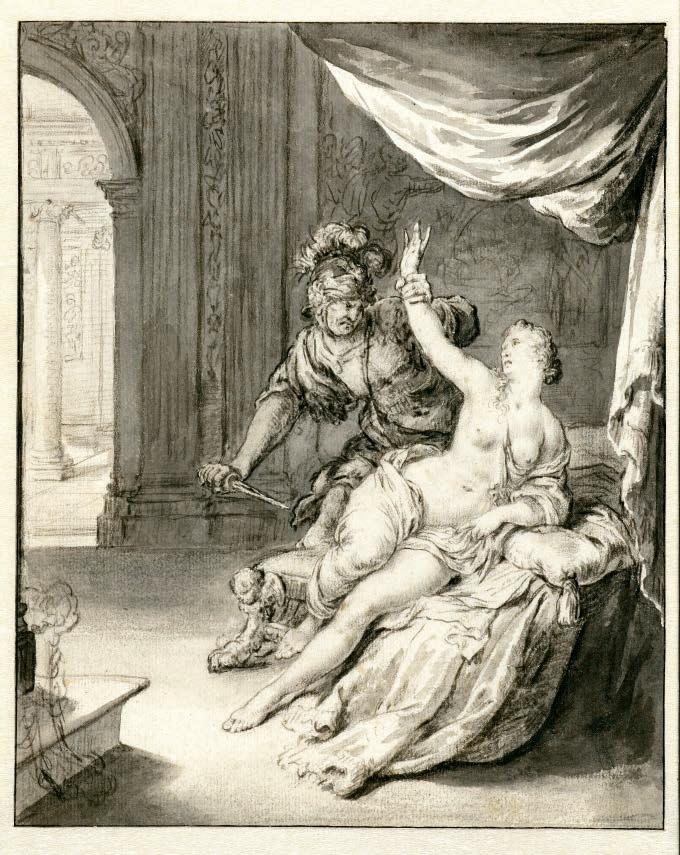
– fig. 6.3 –Willem van Mieris (1662–1747), The Rape of Lucretia. Black chalk and grey wash on paper, 22.9 × 18.4 cm . Rijksprentenkabinet, inv. R P-T-1957-331. Collection Rijksmuseum, Amsterdam. Purchased with the support of the F.G. Waller-Fonds
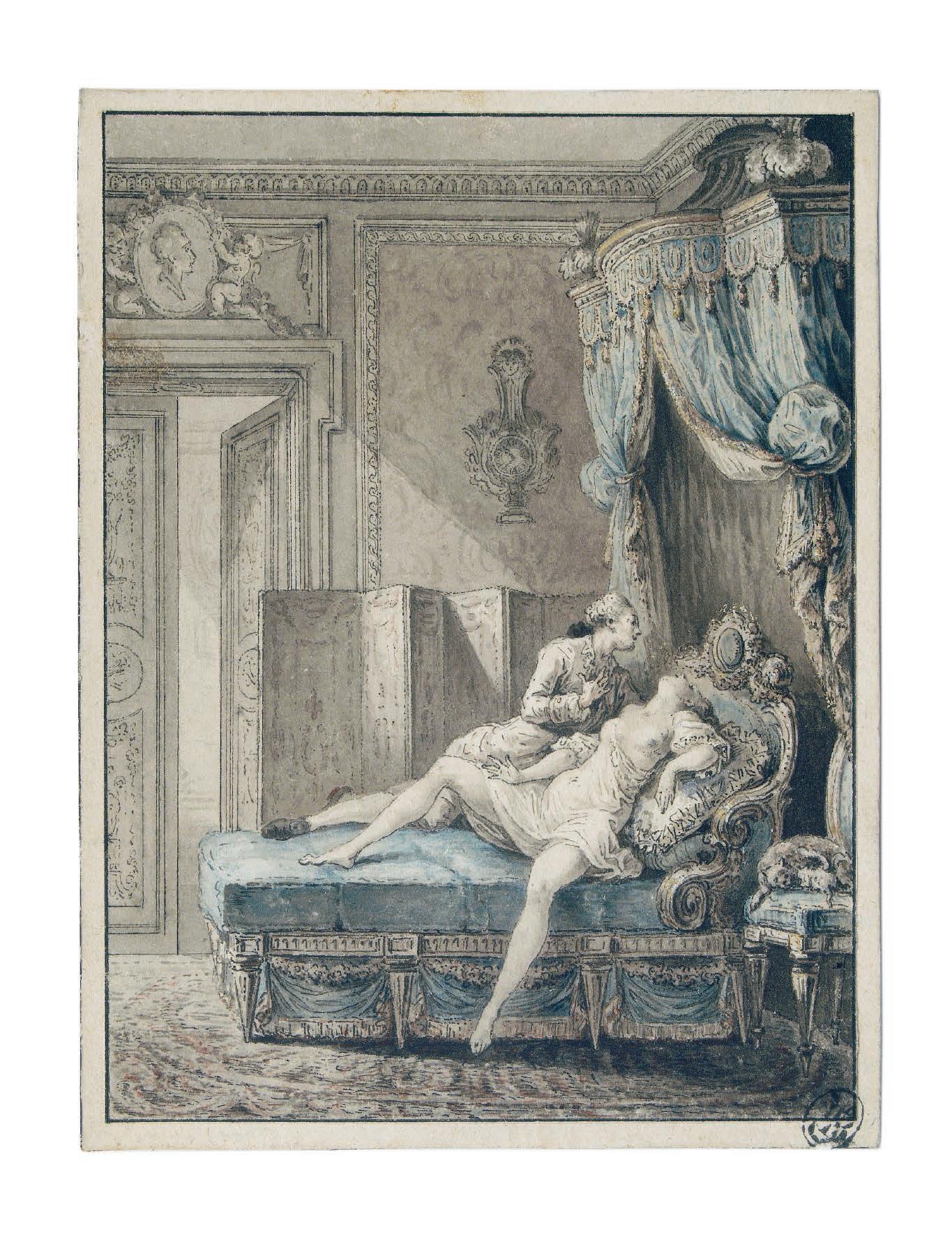
2. TURNER , Nicholas, in CAMBRIDGE , 2000; LISBON , PORTO, 2000–2002 , no. 102, pp. 226–27 (repr.); MADRID, 2002, no. 6 8, pp. 160–61 (repr.).
3. I would like to thank David Scrase, Curator of the museum, for the interest that he showed in the problem of the authorship of the Gulbenkian Collection drawing (2001).
4. See note 1.
5. FONTAINE , Docteur Jean-Paul – Des origines à nos jours – Le Livre des Livres. Paris: 1994, pp. 86–103
touches of red. ¶ When Calouste Gulbenkian acquired this drawing in 1932 at the sale of the Boerner Gallery in Leipzig, its authorship was unknown. Since then several possible names have been suggested, including Gabriel de Saint-Aubin (1724–1780), Jean-Michel Moreau the Younger (1741–1814), and even ClémentPierre Marillier (1740–1808). The possible attribution to this last illustrator came after the exhibition organized by Nicholas Turner, “European Master Drawings from Portuguese Collections”2 , which was shown at the Fitzwilliam Museum in Cambridge in May 2000. This institution owns two drawings by Marillier 3 , both signed and dated 1771, which depict a similar environment and are on a similar scale to the Gulbenkian drawing. These are Les Faux-amis (inv. P D 93–1961) and L’Indigent (inv. P D 84–1961), works that appear to have been intended for prints to be used to illustrate one of the many popular books published in the eighteenth century. This suggestion is lent further credence by the fact that some of the decorative motifs in the Gulbenkian piece (the door, panel and clock) also appear in a drawing by Marillier which was engraved by Pierre-Adrien Le Beau (1744/48- ca. 1817) for Turcaret , a comedy by Alain-René Lesage (1668–1747) 4 . ¶ All of the artists suggested here worked in the field of illustration and contributed to it with the elegance of their drawings, which were then reproduced in intaglio by the most skilled engravers. There were, however, numerous talented illustrators whose compositions graced the literary works of the time, which were also decorated with vignettes, culs-de-lampe and other kinds of typographical ornamentation that contributed to making the eighteenth century, in terms of book production, the “era of the perfect book”5 . ¶ The fact that so far the research has not indentified an eighteenth-century illustrated edition containing a printed image of the Gulbenkian drawing means that not only its authorship but also its intended purpose remains open.
PROVENANCE
Alfred Beurdeley Collection. Sale at Galerie Georges Petit, Paris, 13–15 March 1905. Acquired by Calouste Gulbenkian, through Wildenstein, at a sale at C. G. Boerner Gallery, Leipzig, 9 May 1932, lot no. 3 4 .
• Exhibitions
Cambridge , 2000, no. 102, pp. 226–27, p. 2 27 (repr.); Lisbon, Porto, 200o–2002 , no. 102, pp. 226–27, p. 2 27 (repr.); Madrid, 2002, no. 6 8, pp. 160–61, p. 161 (repr.); Lisbon , 2005, no. 9 8, pp. 256–57, p. 257 (repr.)
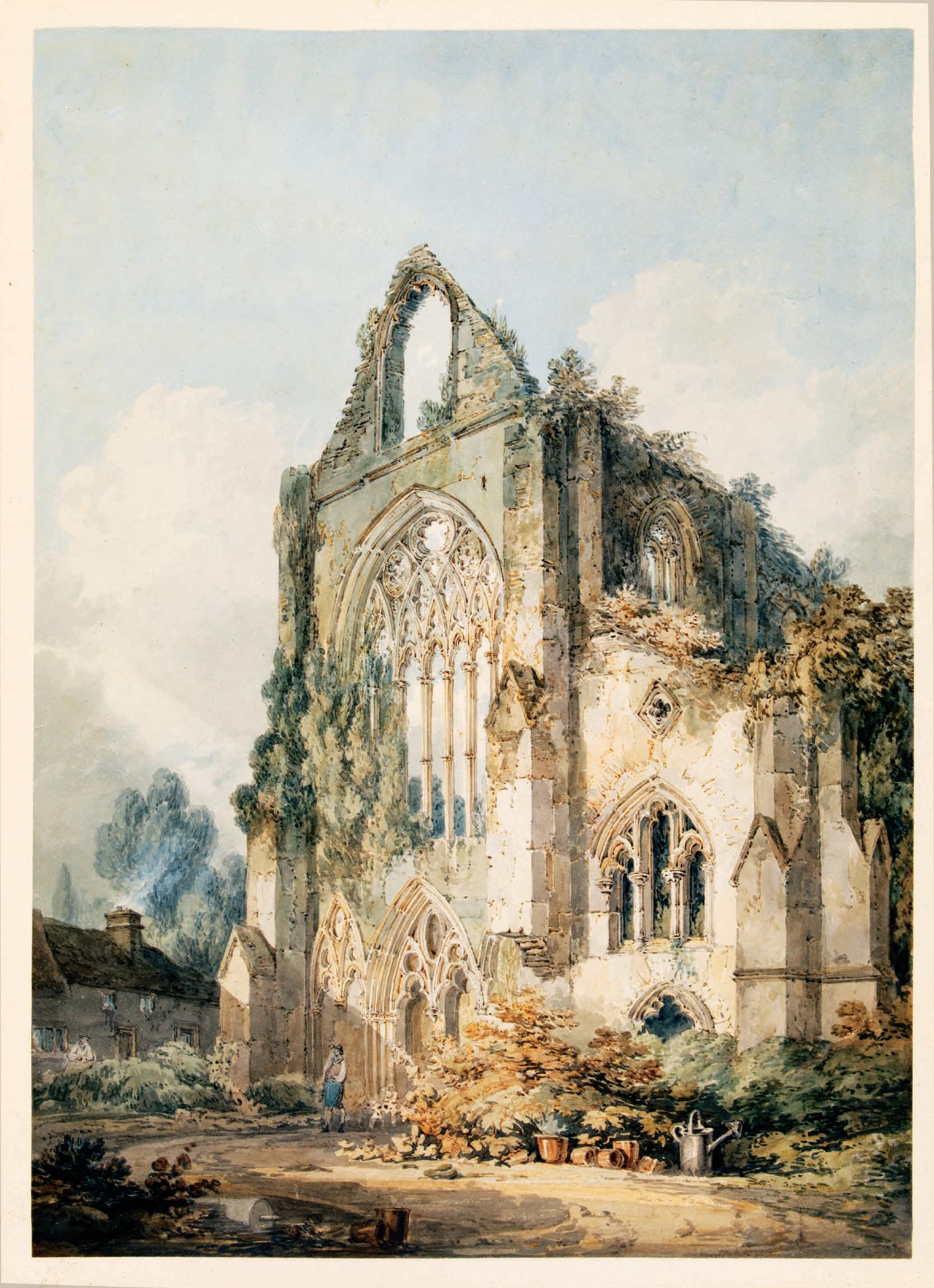
proved to be particularly important in his artistic training. In his youth he created meticulously detailed works that were essentially topographical and were inspired by trips that, at this stage of his life, were limited to regions around the west coast of Britain, Wales and the Isle of Wight, as well as the more frequently visited parts of Kent and Sussex. When he reached maturity he largely sought to employ a visionary imagination in order to express the grandeur and sublimity of the landscape under the dramatic effects of light and atmosphere, an approach which led to real forms becoming gradually dissolved to the point of absolute abstraction. ¶ The watercolour Ruins of Tintern Abbey was painted around 1794, two years after the artist visited Wales for the first time. The beauty of the ruins of this Cistercian abbey, which was founded in the twelfth century, served as an inspiration to several painters, particularly after the publication of William Gilpin’s (1724–1804) work Observations on the River Wye and several parts of South Wales, etc. relative chiefly to Picturesque Beauty; made in the summer of the year 1770 (London, 1782). The building also naturally attracted the attention of Turner, who depicted it in several topographical views, one of which, owned by the British Museum (inv. 1878, 1228.41), closely resembles the Gulbenkian Collection’s. It is

– fig. 21.1 –Joseph Mallord William Turner (1775–1851), The Inside of Tintern Abbey, Monmouthshire, ca. 1794. Watercolour, 32.1 × 25.1 cm . London, Victoria and Albert Museum, inv. 1683-1871 © 2012 Photo Scala, Florence / V&A Images / Victoria and Albert Museum, London
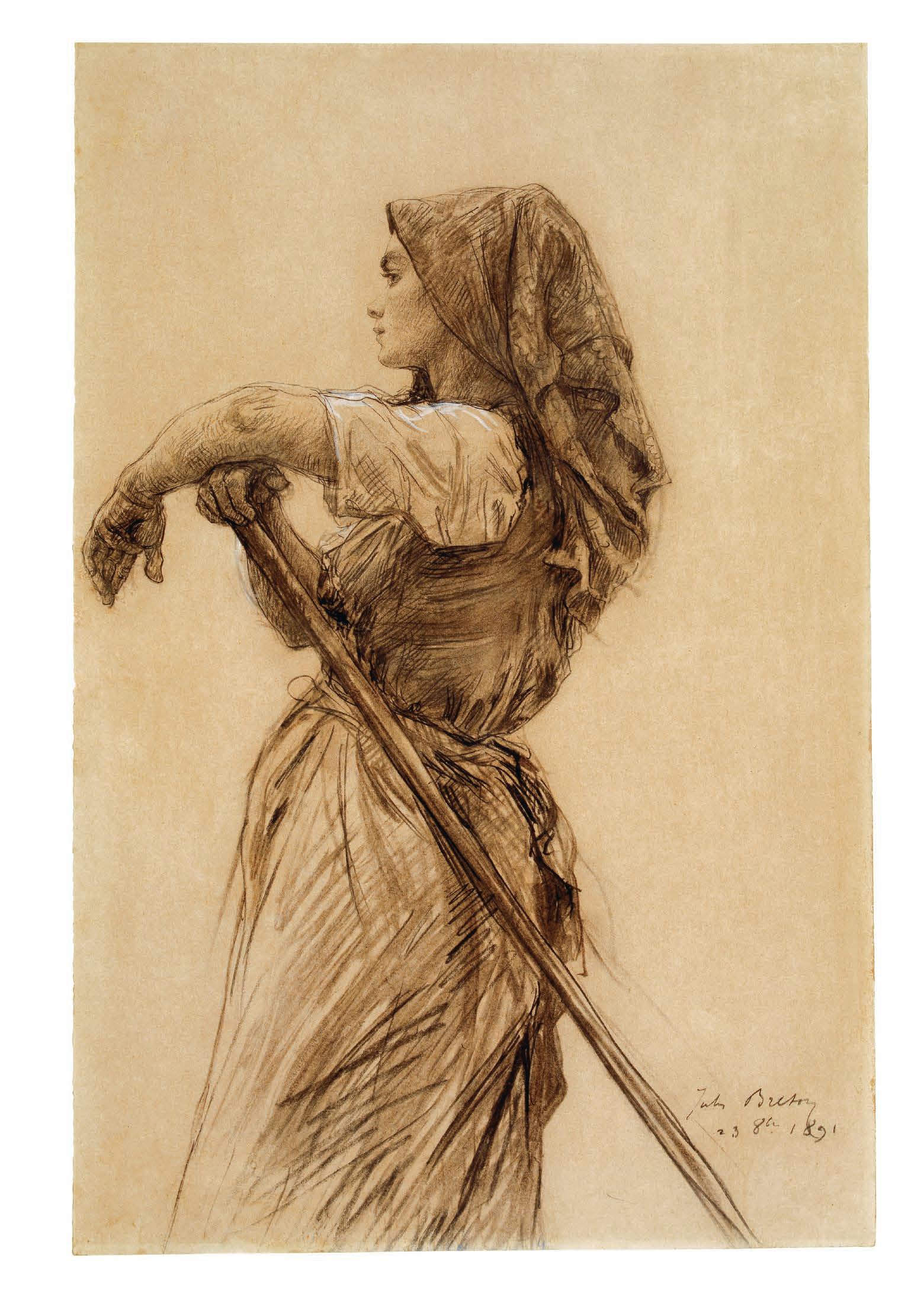
5. With regard to Breton’s painting, Le Rappel des Glaneuses (Paris, musée d’Orsay, inv. M I2 89), which was presented at the 1859 Salon , a contemporary critic defined the female models that the painting depicted as being ‘belles cariatides rustiques’ (beautiful rustic caryatids). See Paris, 1979, p. 314.
6. VACHON , 1899, p. 7 6.
7. Ibidem , hors-texte, n.p. [ between p. 6 8 and p. 6 9].
of misery, thereby maintaining the social harmony of the traditional agricultural community. Modest, devout and active, Breton’s peasants are happy with their lot and grateful for their daily bread. For this reason, while extolling the values that governed their lives, the artist showed his protagonists to be enveloped in an atmosphere of respect, dignity and ‘ancient’ nobility5 . ¶ In his monograph on the work of Jules Breton, Marius Vachon places the themes tackled by the artist in four groups: work, rest, country festivals, and religious festivals 6 . The Gulbenkian drawing Faneuse au repos, which is reproduced twice in the aforementioned publication 7, belongs to the wide range of compositions that make up the second group. Against a background of brownish shades, a close-up view of a peasant woman in three-quarter profile appears. Her position in life is immediately confirmed by the typical rural clothing that she wears: a white short-sleeved blouse, a tight waistcoat, and an apron tied at the waist, covering her skirt. The scarf that completely covers her hair outlines her face, emphasizing her beauty. With her robust shape and classically perfect features, the young woman leans on the end of an agricultural tool while her vague but proud gaze conveys a serenity that comes from the satisfaction of a job well done. This drawing, and the painting to which it is related, were created at the height of the artist’s mature period, when his style became more austere and his compositions less complex, thereby allowing him to focus on creating a nobler and more fitting image of the rural worker. ¶ In his gal-
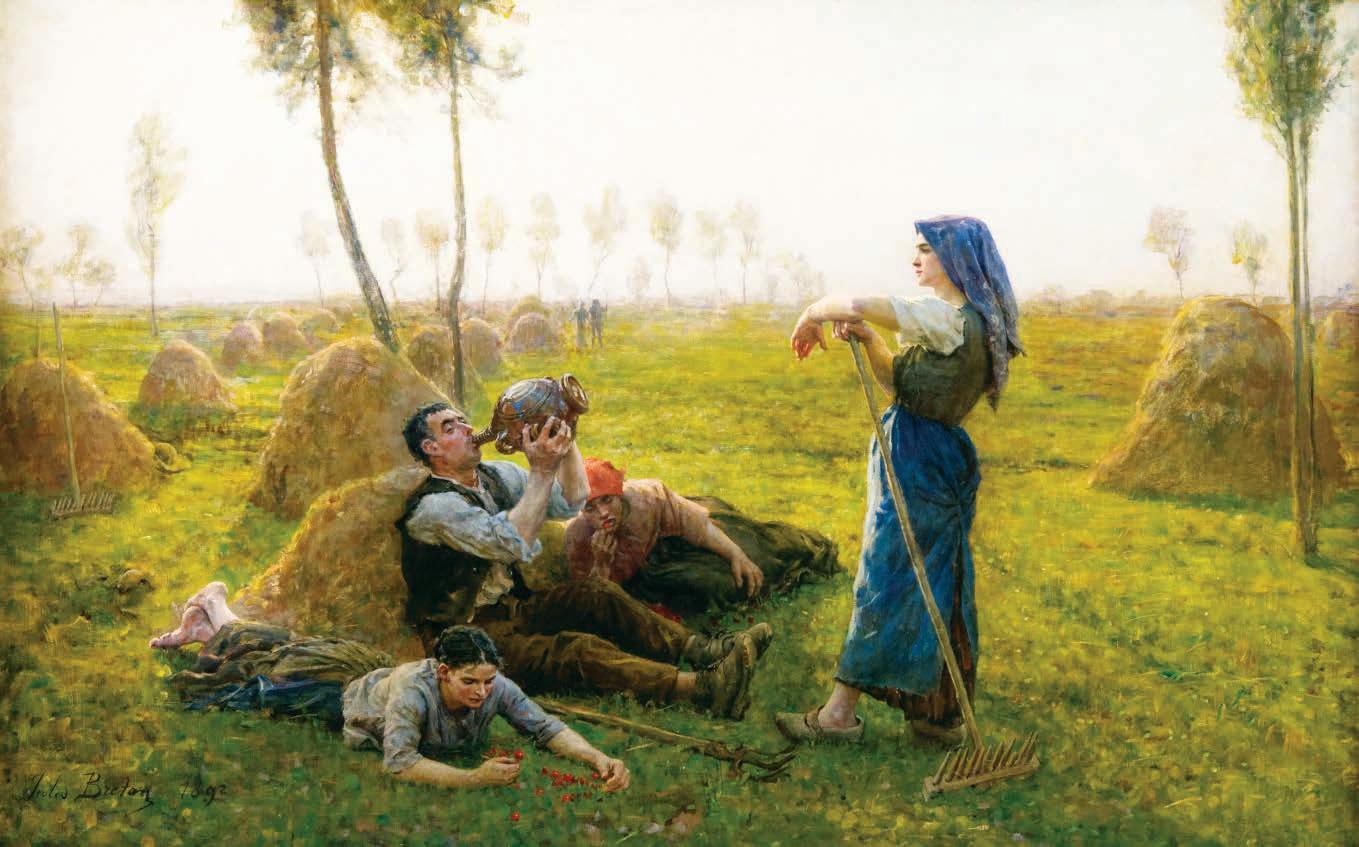
– fig. 2 6.1 –
Jules-Adolphe-Aimé-Louis Breton (1827–1906 ), Juin , 1892. Oil on canvas, 96.5 × 123.2 cm Collection of the Arnot Art Museum, Elmira, New York, USA , inv. 9 8
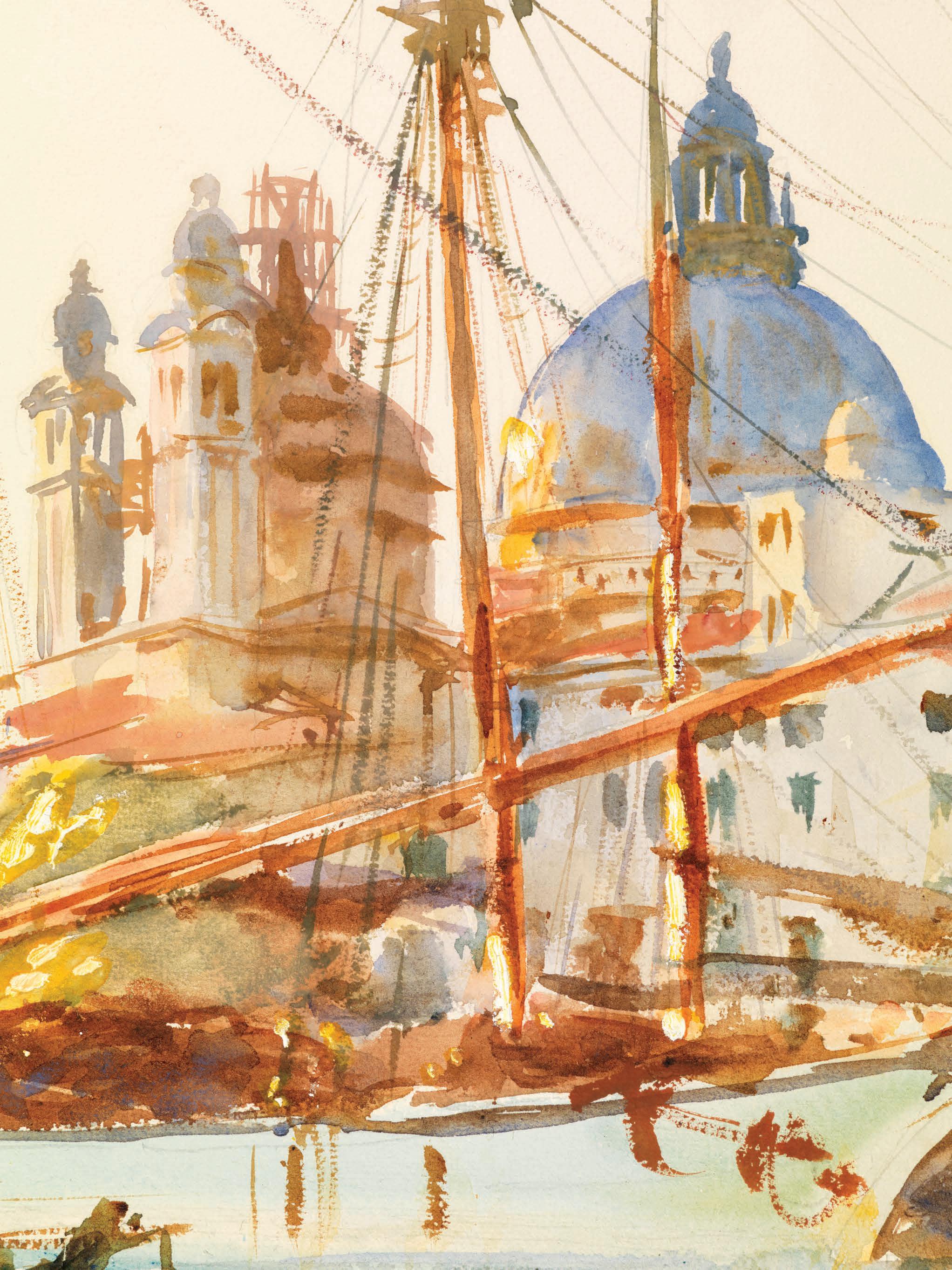
30 ]
PAUL JOUVE
Bourron-Marlotte, 1878 – Paris, 1973
Royal Eagle France, ca. 1914
Conté crayon, white chalk, stump, with touches of ochre pencil on paper. 54.5 × 76.3 cm.
Signature on lower left-hand side: P. Jouve. Inv. 2 219
1. Paris: Le Livre contemporain, 1919, no. 5, printed for Henri Lenseigne from a run of 125. Paul Jouve’s compositions were engraved by FrançoisLouis Schmied (1873–1941). Lisbon, Calouste Gulbenkian Museum, inv. L M381
2. Lausanne: Gonin et Cie, undated [ 1932 ], no. 52 of a run of 150 prints. Paul Jouve’s compositions were engraved by J. L. Perrichon. Lisbon, Calouste Gulbenkian Museum, inv. L M 437.
The painter, sculptor, illustrator and engraver Paul Jouve is represented in the Gulbenkian Collection by two magnificent drawings [ 30–31 ] and by two equally noteworthy books illustrated by him: Le Livre de la Jungle [The Jungle Book] by Rudyard Kipling 1 and Colette’s Paradis Terrestre 2 By acquiring these four works for his collection on separate occasions between 1923 and 1939, Calouste Gulbenkian showed his particular interest in the artist’s graphic work. ¶ Born in Bourron-Marlotte, near the forest of Fontainebleau, Paul Jouve lived in Paris from the age of two. The artistic temperament that he revealed from an early age was recognized and cultivated by his father, a painter and ceramic artist who allowed him to study at the École des Arts Décoratifs. However, the young Paul was interested neither in the traditional vocabulary of the arts nor in studio exercises, and he preferred to make studies directly from nature and in particular from the animal kingdom, which became the overriding theme of all his work. ¶ A painter of animals by his own choice and passion for the subject, he showed an early love of nature and was keen to study the anatomy and behaviour of animals in his quest to understand their relations with their own environments. He liked to observe them directly, firstly in captivity, depicting them in the European zoos, markets and museums that he often visited in his search for different models and new inspirations. However, these depictions of imprisoned animals set outside their natural environments lacked verisimilitude. It was only later, when Jouve saw them in their own habitats during his numerous trips to Africa, the Far East and India, that his interpretations took on the quiddity that enabled them to rank alongside the greatest works of the animal painters of the previous century such as Barye (1796–1875) and Delacroix (1798–1863). In his foreword to Camille Mauclair’s monograph on Jouve, Pierre Bellanger managed to sum up this ability: “I recall hearing, in one of your exhibitions, a foreigner, excited with your lions, elephants, tigers and panthers cry out: ‘Oh! That Jouve, he is the king of animals’. Let me say, in a less lapidary fashion, that you have solved the problem
